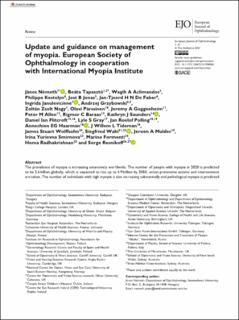Update and guidance on management of myopia. European Society of Ophthalmology in cooperation with International Myopia Institute
| dc.contributor.author | Németh, János | |
| dc.contributor.author | Tapasztó, Beáta | |
| dc.contributor.author | Aclimandos, Wagih A. | |
| dc.contributor.author | Kestelyn, Philippe | |
| dc.contributor.author | Jonas, Jost B. | |
| dc.contributor.author | De Faber, Jan-Tjeerd H. N. | |
| dc.contributor.author | Januleviciene, Ingrida | |
| dc.contributor.author | Grzybowski, Andrzej | |
| dc.contributor.author | Nagy, Zoltán Zsolt | |
| dc.contributor.author | Pärssinen, Olavi | |
| dc.contributor.author | Guggenheim, Jeremy A. | |
| dc.contributor.author | Allen, Peter M. | |
| dc.contributor.author | Baraas, Rigmor C. | |
| dc.contributor.author | Saunders, Kathryn J | |
| dc.contributor.author | Flitcroft, Daniel Ian | |
| dc.contributor.author | Gray, Lyle S. | |
| dc.contributor.author | Polling, Jan Roelof | |
| dc.contributor.author | Haarman, Annechien E. G. | |
| dc.contributor.author | Tideman, J. Willem L. | |
| dc.contributor.author | Wolffsohn, James Stuart | |
| dc.contributor.author | Wahl, Siegfried | |
| dc.contributor.author | Mulder, Jeroen A. | |
| dc.contributor.author | Smirnova, Irina Yurievna | |
| dc.contributor.author | Formenti, Marino | |
| dc.contributor.author | Radhakrishnan, Hema | |
| dc.contributor.author | Resnikoff, Serge | |
| dc.date.accessioned | 2022-02-10T10:19:27Z | |
| dc.date.available | 2022-02-10T10:19:27Z | |
| dc.date.created | 2021-06-21T16:47:43Z | |
| dc.date.issued | 2021 | |
| dc.identifier.citation | Németh, J., Tapasztó, B., Aclimandos, W. A., Kestelyn, P., Jonas, J. B., De Faber, J.-T. H. N., Januleviciene, I., Grzybowski, A., Nagy, Z. Z., Pärssinen, O., Guggenheim, J. A., Allen, P. M., Baraas, R. C., Saunders, K. J., Flitcroft, D. I., Gray, L. S., Polling, J. R., Haarman, A. E. G., Tideman, J. W. L., Wolffsohn, J. S., Wahl, S., Mulder, J. A., Smirnova, I. Y., Formenti, M., Radhakrishnan, H. & Resnikoff, S. (2021). Update and guidance on management of myopia. European Society of Ophthalmology in cooperation with International Myopia Institute. European Journal of Ophthalmology, 31(3), 853-883. | en_US |
| dc.identifier.issn | 1120-6721 | |
| dc.identifier.uri | https://hdl.handle.net/11250/2978209 | |
| dc.description.abstract | The prevalence of myopia is increasing extensively worldwide. The number of people with myopia in 2020 is predicted to be 2.6 billion globally, which is expected to rise up to 4.9 billion by 2050, unless preventive actions and interventions are taken. The number of individuals with high myopia is also increasing substantially and pathological myopia is predicted to become the most common cause of irreversible vision impairment and blindness worldwide and also in Europe. These prevalence estimates indicate the importance of reducing the burden of myopia by means of myopia control interventions to prevent myopia onset and to slow down myopia progression. Due to the urgency of the situation, the European Society of Ophthalmology decided to publish this update of the current information and guidance on management of myopia. The pathogenesis and genetics of myopia are also summarized and epidemiology, risk factors, preventive and treatment options are discussed in details. | en_US |
| dc.language.iso | eng | en_US |
| dc.rights | Navngivelse-Ikkekommersiell 4.0 Internasjonal | * |
| dc.rights.uri | http://creativecommons.org/licenses/by-nc/4.0/deed.no | * |
| dc.title | Update and guidance on management of myopia. European Society of Ophthalmology in cooperation with International Myopia Institute | en_US |
| dc.type | Peer reviewed | en_US |
| dc.type | Journal article | en_US |
| dc.description.version | publishedVersion | en_US |
| dc.rights.holder | © The Author(s) 2021. | en_US |
| dc.source.pagenumber | 853-883 | en_US |
| dc.source.volume | 31 | en_US |
| dc.source.journal | European Journal of Ophthalmology | en_US |
| dc.source.issue | 3 | en_US |
| dc.identifier.doi | https://doi.org/10.1177/1120672121998960 | |
| dc.identifier.cristin | 1917458 | |
| cristin.ispublished | true | |
| cristin.fulltext | original | |
| cristin.qualitycode | 1 |

